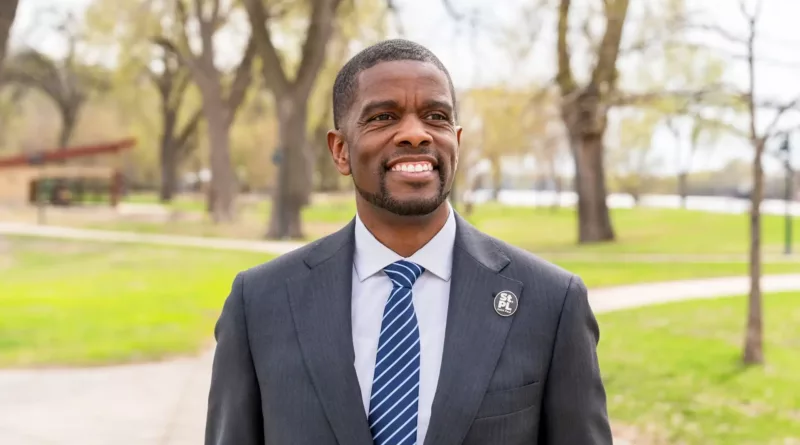Q&A: Melvin Carter
1. What are your three biggest issues facing St. Paul in the coming years and what are your plans to address them?
Our biggest challenges are housing, public safety, and economic inclusion.
First, housing: every family deserves a stable home and a fair shot at home ownership. That’s why we’ve worked to help people stay housed, grow home ownership, and build new housing at every income level. Programs like our Down Payment Assistance and Inheritance Funds have helped families build generational wealth and serve as a national model.
Second, public safety: our Community-First Public Safety framework invests in prevention, intervention, and enforcement. We’re fostering trust by emphasizing community partnerships, youth programs, and crisis response teams to keep every neighborhood safe.
Finally, economic inclusion: finding ways to revitalize our downtown and support small businesses will ensure that our prosperity is shared across every neighborhood.
2. St. Paul residents currently face the highest effective tax rate in the state, one that has the potential to increase again significantly in 2026 with proposed county and city property tax increases and a school district levy on this year’s ballot. What are your plans to address the growing financial pressures on St. Paul’s residents while still providing the services expected of city government?
I know many families have been squeezed by rising costs. That’s why we’re focused on broadening our tax base. By encouraging responsible development, we can grow our city’s revenue through new housing and commercial investment instead of higher taxes on existing homeowners. In Saint Paul we’re streamlining permitting, modernizing city operations, and investing in prevention, because solving problems early is always more cost-effective than reacting later. Programs like our Inheritance Fund and Down Payment Assistance Fund help residents stay in their homes, while our budget prioritizes efficiency and equity in every department. Our goal is to keep Saint Paul affordable, expand opportunity, and deliver strong, reliable services that meet our residents’ expectations without overburdening their pocketbooks.
3. While perceptions of crime in St. Paul may not match reality, with crime rates, especially rates of violent crimes, continuing to fall, our city still has rates close to double that of the rest of the state. How do you plan to address public safety concerns, both those perceived and what is happening in reality, in the city?
Public safety is about more than reducing crime, it’s about investing in people and prevention. Through our Community-First Public Safety framework, we’re investing in our residents alongside law enforcement. We’ve expanded mental health and crisis response teams, youth outreach, and neighborhood partnerships that address root causes of violence. At the same time, we’re using proven strategies to focus enforcement where it’s needed most and ensure accountability across our city. Thanks to our approach, violent crime in Saint Paul has dropped to historic lows. We’re now turning that approach to address quality of life issues like our fentanyl crisis. Real safety is when every person, in every neighborhood, feels safe and supported. That’s the city we’re building together.
4. Downtown St. Paul has long been struggling and, in the past few years, has faced multiple buildings being condemned and changing hands in foreclosure. What are your plans to stabilize downtown St. Paul in order to revitalize what is an important economic engine for St. Paul?
Downtown Saint Paul is the heart of our city and it’s coming back strong. Our plan focuses on turning empty offices into housing, expanding opportunities for retail and restaurants, and creating vibrant mixed-use spaces where people can live, work, and gather. We’re investing in infrastructure, small businesses, and cultural events that make downtown an exciting destination seven days a week. By prioritizing housing at every price point, we’re ensuring downtown’s growth benefits everyone, not just investors. Through partnerships with developers, community organizations, and other levels of government, we’re working to stabilize buildings, attract new employers, and bring more residents downtown. A thriving downtown means a stronger Saint Paul, with more energy, more opportunity, and a broader tax base for our entire city.
5. On August 27, tragedy struck Annunciation Catholic School in Minneapolis where two children were killed and 17 others were injured by a mass shooter. How do you view the City’s role in reducing gun violence and what measures can the City take to curb future mass shootings?
As a Mayor, a Minnesotan, and a father my heart is with the families and community devastated by the tragedy at Annunciation Catholic School. Every child deserves to grow up free from the threat of gun violence, and our city has a moral responsibility to act. That is why this year, I’m bringing forward five measures to the Saint Paul City Council to strengthen local action against gun violence:
- Ban the public possession of assault weapons, large-capacity magazines, and binary triggers within city limits.
- Prohibit untraceable “ghost guns” by requiring all firearms to have serial numbers.
- Restrict firearms in sensitive public spaces such as parks, libraries, recreation centers, and city buildings.
- Require clear signage in public facilities to inform residents of restrictions and encourage compliance.
- Define enforcement authority and penalties—to take effect only if the state repeals or amends its preemption law.
These steps build on our successful Community-First Public Safety framework, which combines prevention, intervention, and accountability to keep our neighborhoods safe. Saint Paul cannot wait for another tragedy to act, we’re taking every step we can to protect our children, our families, and our future.
Visit communityreporter.org/2025election to find each candidate’s response to the full questionnaire, information on how and where to vote, what else is on the ballot and more.




